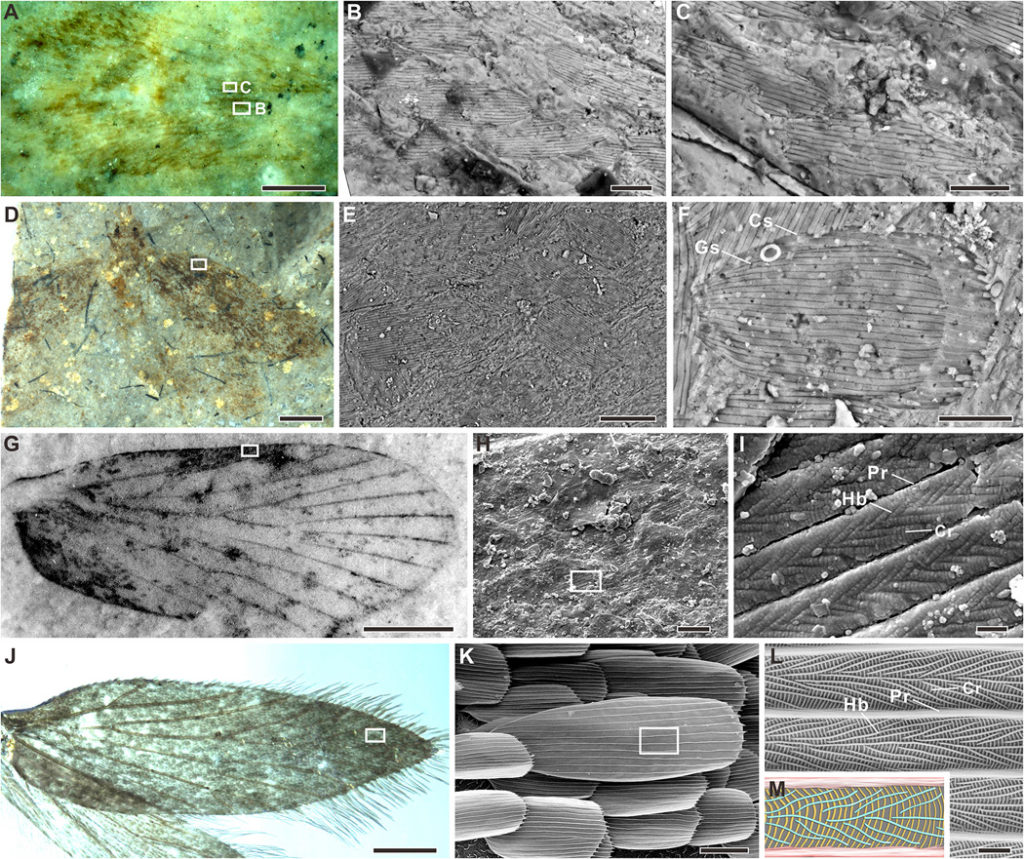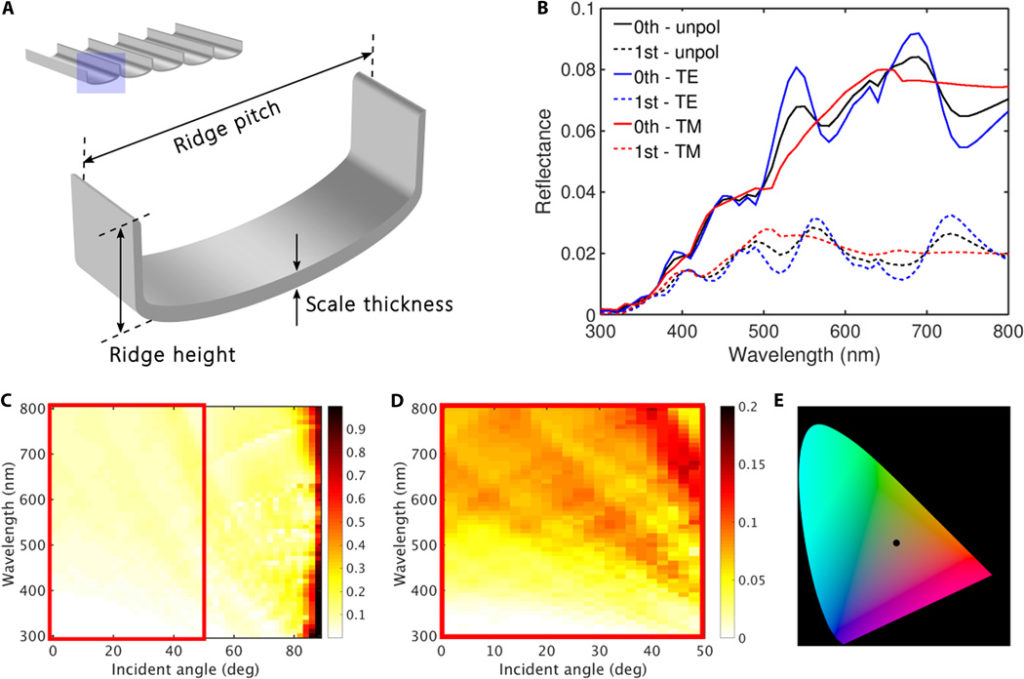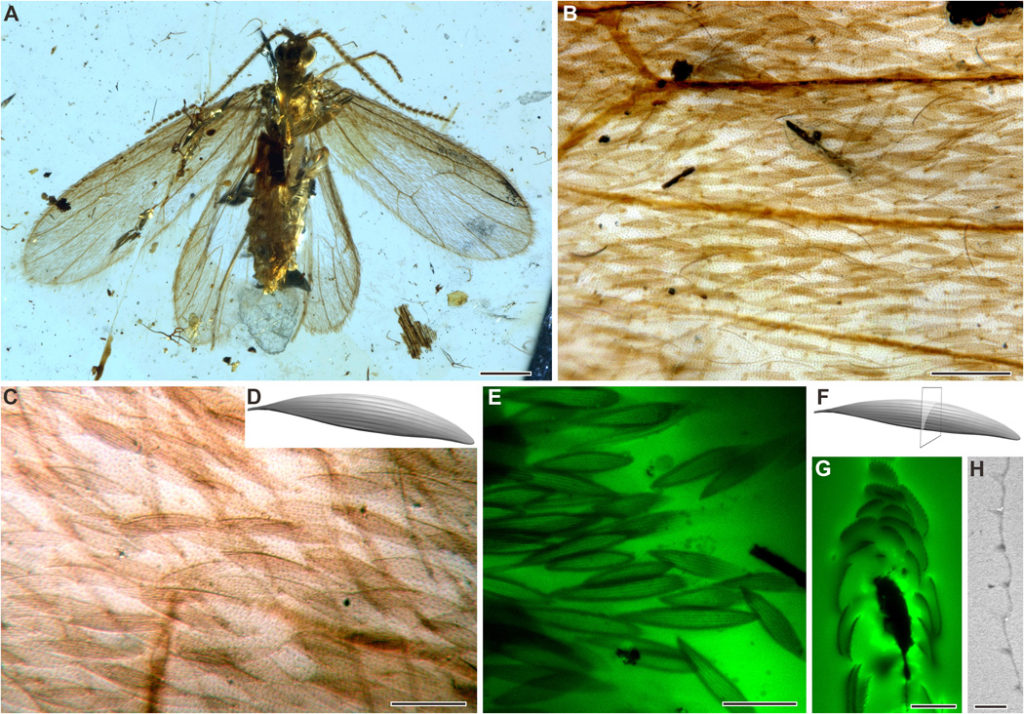@WFS,World Fossil Society,Riffin T Sajeev,Russel T Sajeev

Wings and scales of Jurassic Lepidoptera and extant Micropterigidae.
(A to C) A. mane from the Lower Jurassic of Dorset in England, NHMUK In. 59397. (B and C) SEM images of wing scales. (D to F) Lepidopteran specimen from the Upper Jurassic of Karatau in Kazakhstan, PIN2239/607. (E) Enlargement of forewing in (D), SEM image. (F) Cover scale overlapping ground scale, SEM image. (G to I) Lepidopteran specimen from the Lower Jurassic of Grimmen in Germany, LGA1500. (H) Enlargement of forewing in (G), SEM image. (I) Enlargement of forewing scale in (H), SEM image; note that it is an impression fossil and represents an imprint of the original structure. (J to L) Forewing of extant micropterigid moth (M. aruncella). (K) Enlargement of forewing in (J), SEM image. (L) Enlargement of forewing scale in (K), SEM image. (M) Interpretative sketch of herringbone ultrastructure; the regions between the parallel ridges (red) display a striking herringbone pattern formed by oblique-longitudinal parallel crests (green) superimposed on closely spaced parallel crossribs (yellow). Cr, crossrib; Cs, cover scale; Gs, ground scale; Hb, herringbone crest; Pr, parallel ridge. Scale bars, 1 mm (A, D, and G), 0.5 mm (J), 50 μm (E), 20 μm (B, C, F, H, and K), and 1 μm (I and L). Photo credit: B.W., Nanjing Institute of Geology and Palaeontology, Chinese Academy of Sciences. Used with permission.
Lepidopteran scales exhibit remarkably complex ultrastructures, many of which produce structural colors that are the basis for diverse communication strategies. Little is known, however, about the early evolution of lepidopteran scales and their photonic structures. We report scale architectures from Jurassic Lepidoptera from the United Kingdom, Germany, Kazakhstan, and China and from Tarachoptera (a stem group of Amphiesmenoptera) from mid-Cretaceous Burmese amber. The Jurassic lepidopterans exhibit a type 1 bilayer scale vestiture: an upper layer of large fused cover scales and a lower layer of small fused ground scales. This scale arrangement, plus preserved herringbone ornamentation on the cover scale surface, is almost identical to those of some extant Micropterigidae. Critically, the fossil scale ultrastructures have periodicities measuring from 140 to 2000 nm and are therefore capable of scattering visible light, providing the earliest evidence of structural colors in the insect fossil record. Optical modeling confirms that diffraction-related scattering mechanisms dominate the photonic properties of the fossil cover scales, which would have displayed broadband metallic hues as in numerous extant Micropterigidae. The fossil tarachopteran scales exhibit a unique suite of characteristics, including small size, elongate-spatulate shape, ridged ornamentation, and irregular arrangement, providing novel insight into the early evolution of lepidopteran scales. Combined, our results provide the earliest evidence for structural coloration in fossil lepidopterans and support the hypothesis that fused wing scales and the type 1 bilayer covering are groundplan features of the group. Wing scales likely had deep origins in earlier amphiesmenopteran lineages before the appearance of the Lepidoptera.

Optical modeling showing the photonic response of a simplified fused cover scale structure.
(A) Three-dimensional schematic of the “unit cell” representing the two-dimensional “U-shaped” structure for which simulations were performed, showing the parallel ridges that run longitudinally along the abwing scale surface. Extending the unit cell gives the periodic structure shown at the top left. (B) Reflectance spectra (for excitation at normal incidence) illustrating zeroth-order diffraction (thin-film interference–like; solid lines) and first-order diffraction (dashed lines) for TE (blue lines) and TM (red lines) polarization states. Together, the TE and TM spectra produce the unpolarized response (black lines). (C) The unpolarized zeroth-order response as a function of increasing angle of incidence, with the region enclosed by the red rectangle shown in (D). (E) International Commission on Illumination color chart with the unpolarized zeroth-order spectrum in (B) represented by the black dot illustrating the broadband color produced by the structure in (A).
The structural colours of the fossils studied resulted from light scattering by intricate microstructures, extending the evidence for these light-scattering structures in the insect fossil record by more than 130 million years.
The research team examined fossilised remains dating back 180 million years, with some specimens originating from the Jurassic Coast, only a short distance from Exeter.
Using powerful electron microscopes and using optical models, the team found microscopic ridges and grooves in the insect’s wing scales, similar to those seen in today’s moths. Models revealed these tiny features are photonic structures that would have produced metallic bronze to golden colour appearances in the insect wings.
The research is published in leading journal Science Advances on Wednesday, April 11 2018.
Insects have evolved an amazing range of photonic structures that can produce iridescence, metallic colours, and other flashy effects that are important for behaviour and ecological functions.
Dr Starkey, part of Exeter’s Physics and Astronomy department, said: “The structural colours exhibited by butterflies and moths have been a longstanding research interest in Exeter, and have helped us develop biologically-inspired optical technologies for the present day.

Tarachoptera from mid-Cretaceous Burmese amber.
(A to D) K. brevicostata, female, NIGP164785. (B and C) Forewing scales; note the tubercles and setae on wing membrane. (D) Scale reconstruction. (E to H) K. brevicostata, male, NIGP164786. (E) CLSM images of forewing scales detached from the forewing. (F) Interpretative sketch of cross section of scale. (G) CLSM image of cross section of forewing scales. (H) TEM image of cross section of a forewing scale. Scale bars, 0.5 mm (A), 0.1 mm (B), 50 μm (C), 40 μm (E), 20 μm (G), and 2 μm (H). Photo credit: B.W., Nanjing Institute of Geology and Palaeontology, Chinese Academy of Sciences. Used with permission.
“However, in this study we’ve looked millions of years back in time to early origins of such colours in nature, to understand how and when the evolution of colours in these insects took place.”
The study was co-authored by palaeontologists Drs Maria McNamara and Luke McDonald from UCC, in Ireland. Dr McNamara added: “Remarkably, these fossils are among the oldest known representatives of butterflies and moths.
“We didn’t expect to find wing scales preserved, let alone microscopic structures that produce colour. This tells us that colour was an important driving force in shaping the evolution of wings even in the earliest ancestors of butterflies and moths.”
Dr McDonald, previously of the Natural Photonics group in Exeter, said; “Uniquely in this study, we show that impression fossils, i.e. wing prints, are equally as capable as compression fossils at preserving the structure of scales in sufficient detail to elucidate the moths’ 180 million year old colours.”
- Qingqing Zhang et al. Fossil scales illuminate the early evolution of lepidopterans and structural colours. Science Advances, 2018 DOI: 10.1126/sciadv.1700988
@WFS,World Fossil Society,Riffin T Sajeev,Russel T Sajeev



 April 12th, 2018
April 12th, 2018  Riffin
Riffin  Posted in
Posted in  Tags:
Tags: 